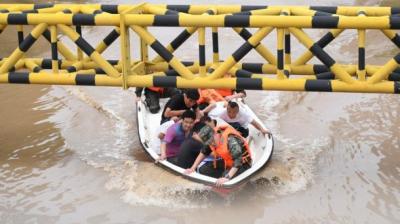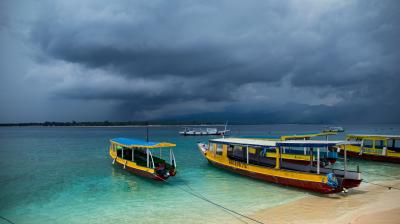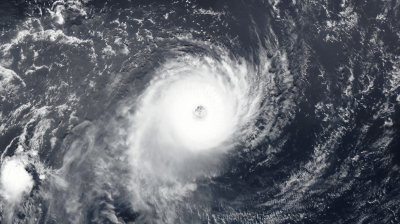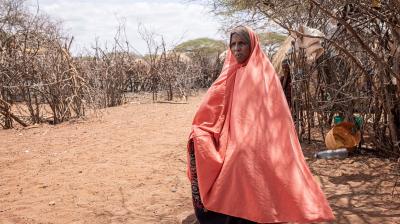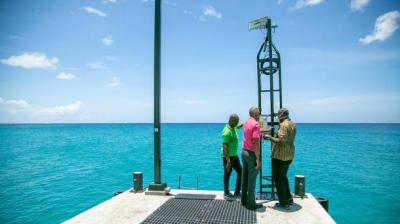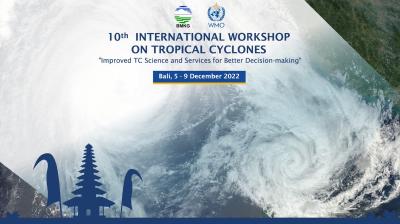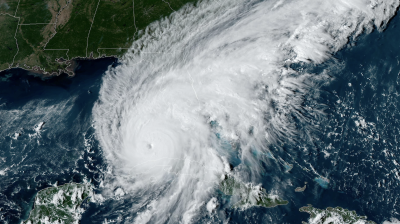Caribbean rolls out multi-hazard preparations for hurricane season

The Caribbean is gearing up for yet another active Atlantic hurricane season, compounded by the continuing challenges and constraints of the COVID-19 pandemic and the ongoing potential for further significant eruptions from the La Soufriere volcano located on the island of St. Vincent which erupted in April 2021.
The triple whammy of hydro-meteorological, health and geological risks has highlighted the need to further enhance multi-hazard early warning system on vulnerable climate sensitive Caribbean Small Island Developing States (SIDS) on the front-line of climate change and its many impacts. It also once again underlines the need for broad regional cooperation across National Meteorological and Hydrological Services, which is embodied by WMO’s Hurricane Committee for North and Central America and the Caribbean (Regional Association IV), national, regional and international specialized agencies as well as academia and the private sector.
The Hurricane season officially begins on 1 June and lasts until 30 November. NOAA’s Climate Prediction Center forecast a 60% chance of an above-normal season, with a likely range of 13 to 20 named storms (winds of 63 kmh / 39 mph or higher), of which 6 to 10 could become hurricanes (winds of 119 kmh / 74 mph or higher), including 3 to 5 major hurricanes (category 3, 4 or 5; with winds of 179 kmh / 111 mph or higher).
Many parts of the region are recovering from the record-breaking 2020 Atlantic hurricane season, which had a record-breaking 30 named tropical storms, including 13 hurricanes and six major hurricanes. The Caribbean was also badly impacted during the 2019 and, in particular, the 2017 season.
“Developing countries and small islands in the Caribbean and Central America are increasingly vulnerable to the impacts of tropical cyclones, which can overturn years of socio-economic development in a matter of hours. In 2020, we saw this once again with tragic effect,” says Evan Thompson, President of WMO’s Regional Association IV.
“We cannot prevent this incredible force of nature, but we do have the power to minimize the loss of life and property through cutting-edge forecasts and warnings and strong regional coordination and cooperation,” says Mr Thompson, who head’s Jamaica’s national meteorological service.
Caribbean Islands with steep terrain are at high risk for landslides and mudflows from heavy rains and volcanic debris. Hurricane winds are strongest at higher altitude than at the surface, so higher terrain has the additional wind hazard.
Meteorological services and disaster management agencies will be working closely with health authorities during the 2021 season to assess and update their preparedness and readiness plans to the new circumstances and challenges to ensure an effective health response during this complex scenario.
The Pan-American Health Organization discussed contingency plans at a meeting on 10 June 2021, including representatives from the WMO and disaster management communities. Challenges for the health sector include the difficulties guaranteeing social distancing and public health measures in overcrowded shelters, resulting in a higher risk of COVID-19 transmission, as well as an increased demand for health services for a larger group of vulnerable people. This is in addition to the traditional risk of destruction of health facilities and increased demand as a result of extreme weather.
Volcanic Eruption

To add to this complexity, the recent eruption of La Soufrière volcano on St. Vincent caused displacement of persons and disruption of livelihoods and economic activities on the island - destroyed infrastructure and the entire agriculture and economic base, and generated volcanic debris, with ashfall adversely affecting nearby Barbados, in particular, and Saint Lucia. The ash was transported as far as Europe and Asia.
The RAIV Hurricane Committee virtual session in May heard how the Meteorological Service of St Vincent and the Grenadines provided volcano support to the National Emergency Council and National Emergency Management Organization(NEMO), tailored forecasts were provided to the University of the West Indies Seismic Research Centre for onsite activities, anticipating rain-soaked ash, disruptions to the water supply and early warnings on heavy rain events, among other things.
Barbados Met Service (BMS) supported St Vincent and the Grenadines with forecast and warnings and by requesting rapid scan of the GOES Satellite over the volcano, in coordination with the Caribbean Meteorological Organization Headquarters. . The BMS is also critical to their national multi-hazard response, where they provided impact-based forecasts and warnings (e.g., providing guidance to the Barbados Water Authority on significant rain events, which the Water Authority then used to make decisions on how to manage high water demand for ash removal in areas still recovering from drought; wind forecasts for airport cleanup; and information on wind and rain to parent Ministry of Agriculture). The BMS is expected to automate future tsunami alert messages.
Volcanic ash and gas atmospheric transportation modeling at the Caribbean Institute for Meteorology and Hydrology (CIMH) was provided several times daily to the NMHSs across the region, including St. Vincent and the Grenadines, to guide their assessment and warning activities. The information was also shared with the Caribbean Disaster Emergency Management Agency (CDEMA) and the Caribbean Development Partner Group – Disaster Management (CDPG-DM) through briefings to inform their decision-making processes. The CIMH also provided estimates of ash and associated grain sizes deposited on Barbados to the Government of Barbados and the University of the West Indies Seismic Research Centre (UWI SRC) among others.
A considerable amount of ash was deposited on St. Vincent and the Grenadines and to a lesser degree Barbados. With the onset of the rainy season, there is the significant potential on St. Vincent and Grenadines for the remobilization of this ash into rivers, streams, lakes and marine environments leading to (i) significant debris build ups that can enhanced flood potential along rivers and in coastal areas, (ii) increased turbidity that can decrease water quality and clog surface water extraction systems leading to closure of such systems, and (iii) enhanced turbidity and decreased water quality in coastal and near coastal environments that may disrupt coastal habitats, fisheries and coastal economic activities such as tourism and watersports. The risks from such impacts will need to be assessed through an integrated multi-hazard, multi-sector and multi-stakeholder assessment process that will include NMHSs and RCCs.
Lightning Symposium
Lightning causes many deaths, injuries, and property damage each year. Additionally, the economies of least-developed countries, such as those in the Caribbean and Central America, suffer due to property loss, damage of electrical and electronic equipment and systems, downtime due to service outages and data losses and problems in power quality.
The first-ever Symposium on Lightning and Lightning Safety Awareness, hosted jointly by the Caribbean Meteorological Organization (CMO) and the World Meteorological Organization (WMO) on May 19-20, brought together lightning specialists from a wide range of disciplines. The event was part of CMO’s initiative to foster collaboration to better understand lightning risk and improve safety in the Caribbean and the Inter-Americas to reduce lightning deaths, injuries, and property damage.
“The symposium was a pioneering forum for exchanging information and resources on lightning and its impacts” said Dr. Arlene Laing, Coordinating Director of the CMO Headquarters and organizer of the event. “With support from the WMO, we were able to bring together specialists from across the world to share presentations about lightning safety education and awareness, medical impacts of lightning and injury prevention, lightning protection measures, weather forecast applications, lightning detection, and lightning as an essential climate variable,” explained Laing.
- WMO Member:
- Antigua and Barbuda ,
- Barbados ,
- Belize ,
- Cuba ,
- Dominican Republic ,
- Dominica ,
- Guyana ,
- Jamaica ,
- Saint Lucia ,
- Trinidad and Tobago ,
- Haiti ,
- United States of America ,
- Curaçao and Sint Maarten


